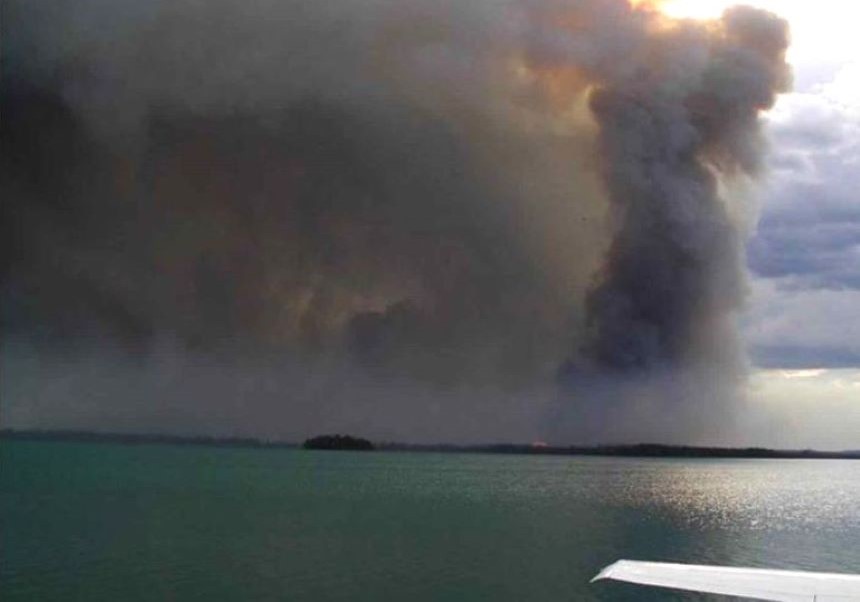CIDE analyses the impact of forest fires on marine ecosystems
- Science Park
- January 26th, 2024

An article published in the journal Trends in Ecology & Evolution by the Desertification Research Centre (CIDE, UV-CSIC-GVA) and the ECOAQUA Institute (ULPGC) proposes for the first time a conceptual framework for the study of fire ecology in the marine environment. The work warns about the disturbances caused by forest fires in marine systems and raises the main ideas and questions to be resolved from this new study perspective.
Forest fires are one of the main ecological disturbances of various terrestrial ecosystems such as boreal forests, temperate forests, Mediterranean shrublands, tropical savannahs and grasslands. In these ecosystems, an important part of the byproducts generated by forest fires – ash, smoke and sediments – reach the ocean by land via runoff and rivers, and by atmospheric means, through aerosols.
With global warming, foreseeable trends point to an increase in fire activity, which will result in greater deposition in marine ecosystems of materials related to forest fires. However, understanding the impact of these disturbances on these ecosystems, both on water quality and marine biota, is still anecdotal and requires further analysis.
“Forest fires are expected to have a significant impact on the ecology of the oceans. The byproducts of wildfires will likely increase nutrient transport from land to sea, alter marine chemistry and carbon and nutrient cycling, as well as phytoplankton productivity, and have effects on ocean biota”, explains Juli G. Pausas, CSIC researcher at CIDE and leader of this work.
Prominent examples of these effects are found in Indonesia, where extensive forest fires in 1997 caused red tides throughout the archipelago for two months and resulted in significant mortality of phytoplankton, zooplankton, and benthic seafloor organisms, as well as of corals in a 400 kilometre stretch on the Mentawai Islands. Or during the Australian fires of 2019 and 2020, when the released aerosols initiated a prolonged phytoplankton bloom in the South Pacific Ocean, which lasted 4 months and generated extensive carbon fixation.
According to the study, quantifying the direct effects on fish, corals and plankton would allow us to better understand the dynamics of marine ecosystems after fires, thus broadening the spectrum of analysis. The work also suggests delving into the functional and adaptive responses of the different species that occupy these habitats to better understand the mechanisms that maintain biodiversity in fire-prone marine ecosystems.
The oceans: sinks for forest fire emissions
Approximately 6% of the carbon sequestered in marine sediments is of pyrogenic origin, that is, from the carbonised compounds generated during fires that flow from the soil through rivers to reach the oceans. “The deposition and accumulation of these compounds have significant implications for the carbon cycle, functioning as a geological carbon sink for long periods of time”, says Pausas.
Quantifying the role that marine microbes and phytoplankton play in capturing carbon emissions from wildfires is also a crucial, but underexplored, field of research. Delving deeper into this area would not only improve the understanding of global biogeochemical cycles, but would help fine-tune the global carbon balance. “It is essential to integrate this aspect into global carbon models and, at the same time, improve our ability to quantify the transfer of carbon to the ocean through runoff and sedimentation”, explains Rodrigo Riera, BIOCON researcher at the ECOAQUA Institute of the University of Las Palmas de Gran Canaria. For all these reasons, “we must address the ecology of fire in the marine environment to fully understand the impact of forest fires on our planet. This would enrich our knowledge of the interconnected systems that make up the Earth,” concludes Pausas.
The study is published in the journal Trends in Ecology & Evolution by researchers from the Desertification Research Centre (CIDE), a joint centre of the Spanish National Research Council (CSIC), the University of Valencia (UV) and the Valencian Government, in collaboration with the Biodiversity and Conservation Research Group (BIOCON) of the ECOAQUA Institute (University of Las Palmas de Gran Canaria).
Reference:
Rodrigo Riera, Juli G. Pausas. Fire ecology in marine systems. Trends in Ecology & Evolution. 2023. DOI: https://doi.org/10.1016/j.tree.2023.12.001
File in: Ciencias de la Tierra y el Espacio
















